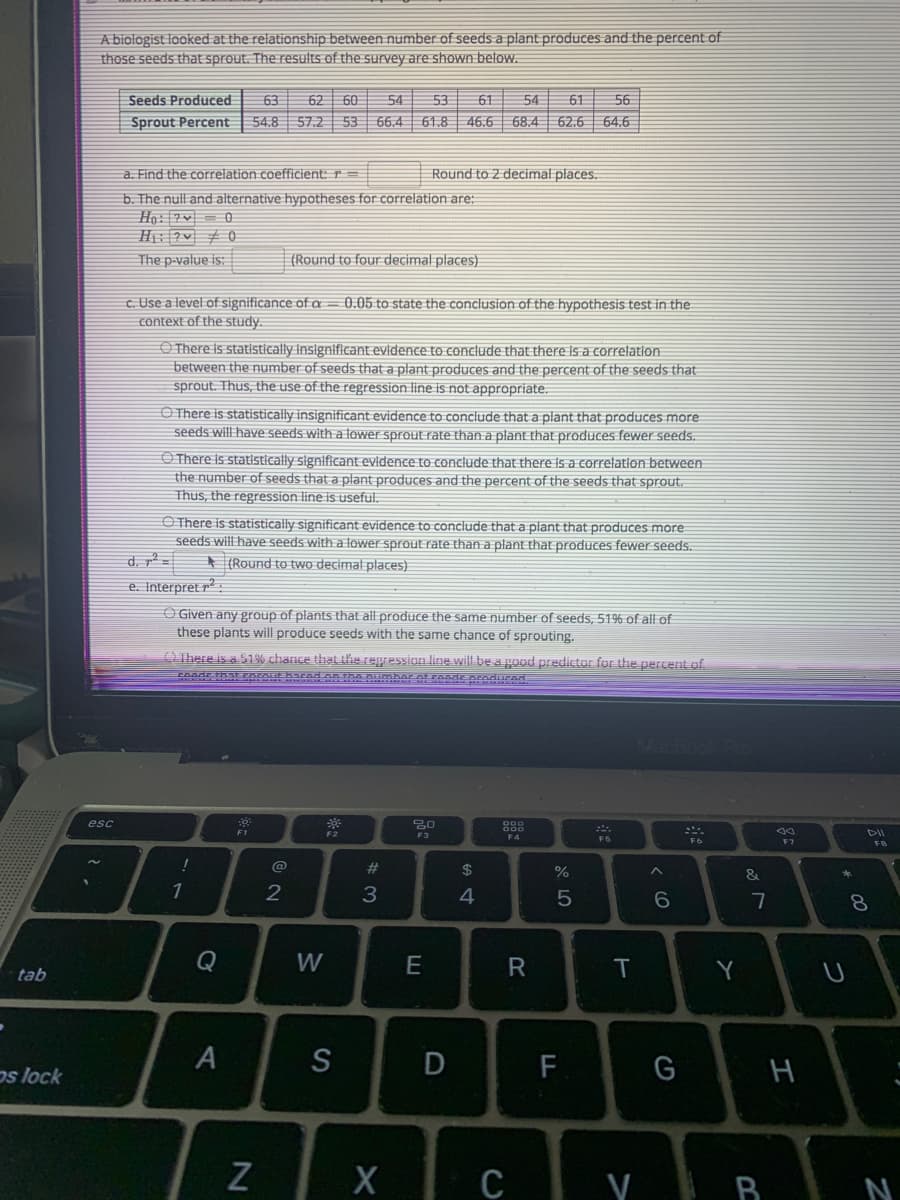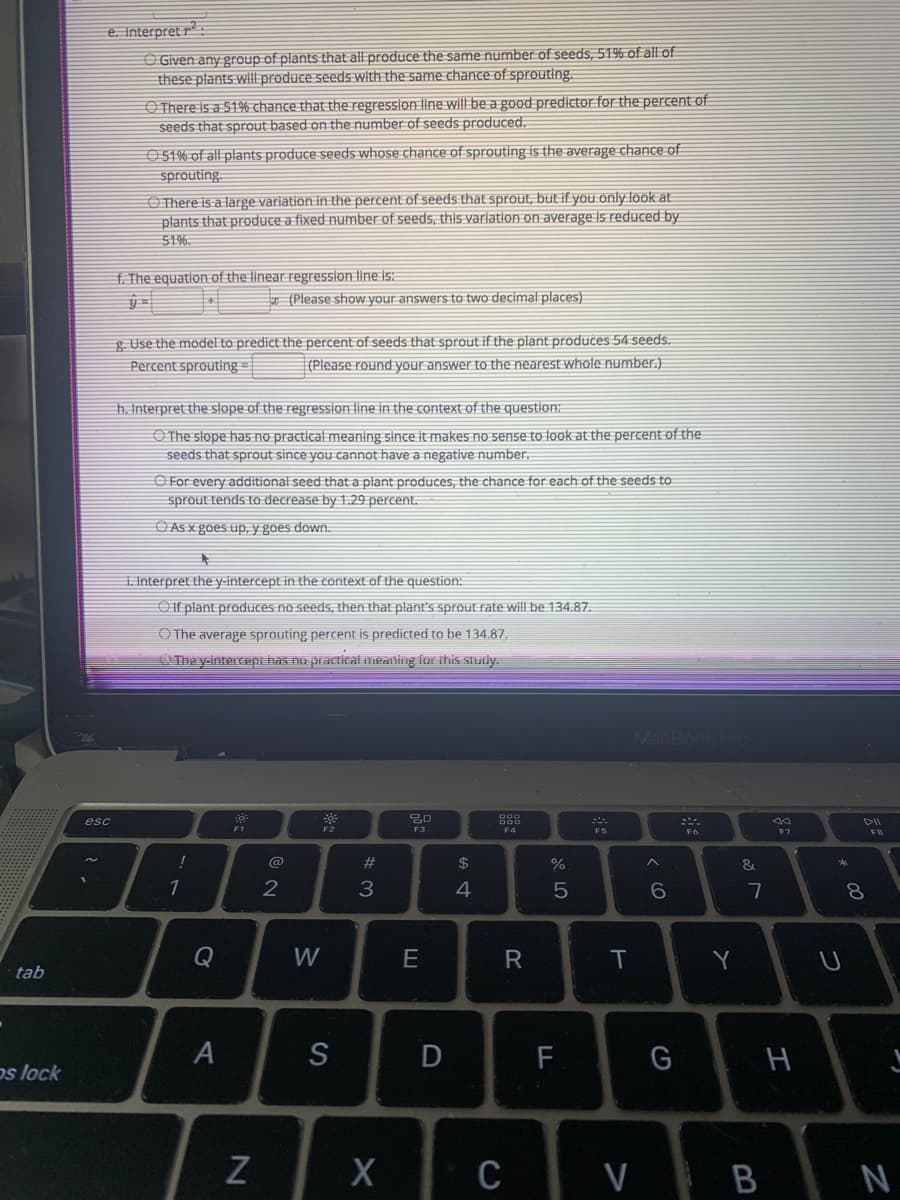A biologist looked at the relationship between number of seeds a plant produces and the percent of those seeds that sprout. The results of the survey are shown below. Seeds Produced 63 62 60 54 53 61 54 61 56 Sprout Percent 54.8 57.2 53 66.4 61.8 46.6| 68.4 | 62.6 64.6 a. Find the correlation coefficient: r = Round to 2 decimal places. b. The null and alternative hypotheses for correlation are: Ho:2 0 The p-value is: (Round to four decimal places) c. Use a level of significance of a = 0.05 to state the conclusion of the hypothesis test in the context of the study. O There is statistically insignificant evidence to conclude that there is a correlation between the number of seeds that a plant produces and the percent of the seeds that sprout. Thus, the use of the regression line is not appropriate. O There is statistically insignificant evidence to conclude that a plant that produces more seeds will have seeds with a lower sprout rate than a plant that produces fewer seeds. O There Is statistically significant evidence to conclude that there is a correlation between the number of seeds that a plant produces and the percent of the seeds that sprout. Thus, the regression line is useful. O There is statistically significant evidence to conclude that a plant that produces more seeds will have seeds with a lower sprout rate than a plant that produces fewer seeds.
A biologist looked at the relationship between number of seeds a plant produces and the percent of those seeds that sprout. The results of the survey are shown below. Seeds Produced 63 62 60 54 53 61 54 61 56 Sprout Percent 54.8 57.2 53 66.4 61.8 46.6| 68.4 | 62.6 64.6 a. Find the correlation coefficient: r = Round to 2 decimal places. b. The null and alternative hypotheses for correlation are: Ho:2 0 The p-value is: (Round to four decimal places) c. Use a level of significance of a = 0.05 to state the conclusion of the hypothesis test in the context of the study. O There is statistically insignificant evidence to conclude that there is a correlation between the number of seeds that a plant produces and the percent of the seeds that sprout. Thus, the use of the regression line is not appropriate. O There is statistically insignificant evidence to conclude that a plant that produces more seeds will have seeds with a lower sprout rate than a plant that produces fewer seeds. O There Is statistically significant evidence to conclude that there is a correlation between the number of seeds that a plant produces and the percent of the seeds that sprout. Thus, the regression line is useful. O There is statistically significant evidence to conclude that a plant that produces more seeds will have seeds with a lower sprout rate than a plant that produces fewer seeds.
Glencoe Algebra 1, Student Edition, 9780079039897, 0079039898, 2018
18th Edition
ISBN:9780079039897
Author:Carter
Publisher:Carter
Chapter4: Equations Of Linear Functions
Section4.5: Correlation And Causation
Problem 2BGP
Related questions
Topic Video
Question

Transcribed Image Text:A biologist looked at the relationship between number of seeds a plant produces and the percent of
those seeds that sprout. The results of the survey are shown below.
Seeds Produced
63
62
60
54
53
61
54
61
56
Sprout Percent
54.8 57.2 53 66,4 | 61.8 46.6| 68,4 | 62,6| 64.6
a. Find the correlation coefficient: ↑ =
Round to 2 decimal places.
b. The null and alternative hypotheses for correlation are:
The p-value s:
(Round to four decimal places)
c. Use a level of significance of a = 0.05 to state the conclusion of the hypothesis test in the
context of the study.
O There Is statlstically insignificant evidence to onclude that there is a correlation
between the number of seeds that a plant produces and the percent of the seeds that
sprout. Thus, the use of the regression line is not appropriate.
O There is statistically insignificant evidence to conclude that a plant that produces more
seeds will have seeds with a lower sprout rate than a plant that produces fewer seeds.
O There is statistically significant evidence to conclude that there Is a correlation between
the number of seeds that a plant produces and the percent of the seeds that sprout.
Thus, the regression line is useful,
O There is statistically significant evidence to conclude that a plant that produces more
seeds will have seeds with a lower sprout rate than a plant that produces fewer seeds.
d. p² =
A (Round to two decimal places)
e. Interpret r
O Given any group of plants that all produce the same number of seeds, 51% of all of
these plants will produce seeds with the same chance of sprouting.
OThere is a 51% chance that the repression line will be a pood predictor for the percent of
eede that cnZSat harad An the Qumber et FAade Brodurad.
esc
888
F1
F2
F3
DII
F6
F7
!
@
2#
2$
&
3
Q
W
T
Y
tab
S
F
ps lock
C y R N

Transcribed Image Text:e. Interpret rº
O Given any group of plants that all produce the same number of seeds, 51% of all of
these plants wil produce seeds with the same chance of sprouting.
O There is a 51% chance that the regression line will be a good predictor for the percent of
seeds that sprout based on the number of seeds produced.
O51% of all plants produce seeds whose chance of sprouting is the average chance of
sprouting.
O There is a large variation in the percent of seeds that sprout, but if you only look at
plants that produce a fixed number of seeds, this varlation on average is reduced by
51%.
f. The equation of the linear regression line is:
T (Please show your answers to two decimal places)
g. Use the model to predict the percent of seeds that sprout if the plant produces 54 seeds.
Percent sprouting =|
(Please round your answer to the nearestE whole number.).
h. Interpret the słope of the regression line in the context of the question:
O The slope has no practical meaning since it makes no sense to look at the percent of the
seeds that sprout since you cannot have a negative number.
O For every additional seed that a plant produces, the chance for each of the seeds to
sprout tends to decrease by 1.29 percent.
O As x goes up, y goes down.
キ
i. Interpret the y-intercept in the context of the question:
O if plant produces no seeds, then that plant's sprout rate wil be 134.87.
O The average sprouting percent is predicted to be 134.87,
OThey-intercept has no practical memning for this study.
MacBook PrO
esc
F3
F4
F5
F7
FB
@
#3
2$
%
&
1
2
4
7
8.
Q
W
E
tab
S
D
F
os lock
C
V B
< cO
Expert Solution
This question has been solved!
Explore an expertly crafted, step-by-step solution for a thorough understanding of key concepts.
Step by step
Solved in 3 steps with 5 images

Knowledge Booster
Learn more about
Need a deep-dive on the concept behind this application? Look no further. Learn more about this topic, statistics and related others by exploring similar questions and additional content below.Recommended textbooks for you

Glencoe Algebra 1, Student Edition, 9780079039897…
Algebra
ISBN:
9780079039897
Author:
Carter
Publisher:
McGraw Hill

Glencoe Algebra 1, Student Edition, 9780079039897…
Algebra
ISBN:
9780079039897
Author:
Carter
Publisher:
McGraw Hill